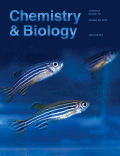 A 2014 paper containing data manipulated by a former graduate student has finally been retracted, two years after the U.S. Office of Research Integrity (ORI) published its findings.
A 2014 paper containing data manipulated by a former graduate student has finally been retracted, two years after the U.S. Office of Research Integrity (ORI) published its findings.
In August 2015, the ORI published a report that Peter Littlefield, who was working on his PhD at the University of California, San Francisco (UCSF), had committed “research misconduct by falsifying and/or fabricating data” in two papers. Littlefield agreed to correct or retract the papers–one published in Chemistry & Biology and the other in Science Signaling.
When we contacted Chemistry & Biology back in August 2015, a spokesperson for Cell Press told us the journal was figuring out “the best way to correct the scientific record.”
Apparently that took two years. In the meantime, the journal did not issue an expression of concern or otherwise notify readers of the issues.
This month, Chemistry & Biology has finally retracted the paper “An ATP-Competitive Inhibitor Modulates the Allosteric Function of the HER3 Pseudokinase.”
But in the two years since the ORI report, issued Aug. 25 2015, and Retraction Watch’s coverage that same day, the paper has been cited nine times, according to Clarivate Analytics’ Web of Science.
What took so long to retract the paper?
A spokesperson for Cell Press, which publishes Chemistry & Biology, said the journal had no further comment on the retraction.
Here’s the retraction notice in Chemistry & Biology:
This article describes the structure of the HER3 pseudokinase domain with bosutinib and finds that bosutinib potentiates allosteric activity of the HER3 pseudokinase. Following an independent investigation by the US Office of Research Integrity (ORI), it was concluded that the first author, Peter Littlefield, engaged in data manipulation and alteration, and it was found that some of the data points in Figures 3C, 4A, and 4B had been changed from the original values. The error bars in Figure 4A were also affected (the full report can be found here: https://ori.hhs.gov/content/case-summary-littlefield-peter). Although these manipulations do not change the major contributions of this paper, given that data in the published paper has been manipulated and the first author engaged in misconduct, we have no other recourse but to retract the paper. We apologize to the research community for the inconvenience.
The paper has been cited a total of 16 times.
The other paper, “Structural analysis of the /HER3 heterodimer reveals the molecular basis for activating HER3 mutations,” published in Science Signaling, received an extensive correction on Sept. 1, 2015. The erratum (behind a paywall) detailed the fabrication affecting several figures, and explained that the authors repeated the relevant experiments and corrected the problematic figures. The paper has been cited 17 times (15 since the erratum was published).
We reached out to Littlefield, who is now an SAT tutor. We didn’t hear back, but according to his tutoring bio, he “began a biochemistry Ph.D. program at UCSF” and has “since left that program to further explore my interests in education and clinical medicine.”
We also contacted Natalie Jura, principle investigator in the lab where Littlefield worked and last author on both papers. Although we did not hear back from Jura, in September 2015, we received a statement from the university’s associate vice chancellor and research integrity officer, which explained that Jura:
… has not been implicated in any research misconduct finding by the U.S. Department of Health and Human Services Office of Research Integrity (ORI) or by UCSF.
Journals can take months, sometimes years to retract papers flagged in ORI investigations. For Eric Poehlman, a researcher who was found guilty of misconduct in 2005, one journal took 12 years to retract a paper. But in the case of Brandi M. Baughman, a former research training awardee at the National Institutes of Health, PLOS ONE took about a month to retract a paper after the authors alerted the editors of their concerns.
Like Retraction Watch? Consider making a tax-deductible contribution to support our growth. You can also follow us on Twitter, like us on Facebook, add us to your RSS reader, sign up on our homepage for an email every time there’s a new post, or subscribe to our daily digest. Click here to review our Comments Policy. For a sneak peek at what we’re working on, click here.
It would be good if somebody could do a comprehensive study of how long journals take to retract articles. My impression is not only that some journals take a long time but that some journals fail altogether to retract articles that have been show to be fraudulent. If a legitimate body like a university has declared work to be suspect, then I can’t see any reason why a journal should not retract the study at once.
There is a broader question about whether it should be necessary to prove a study fraudulent, which is often hard, or whether journals should signal doubts in some way, perhaps by retraction. The level of proof needed in criminal cases (“beyond all reasonable doubt in English law” in English law) does not seem right for scientific studies.